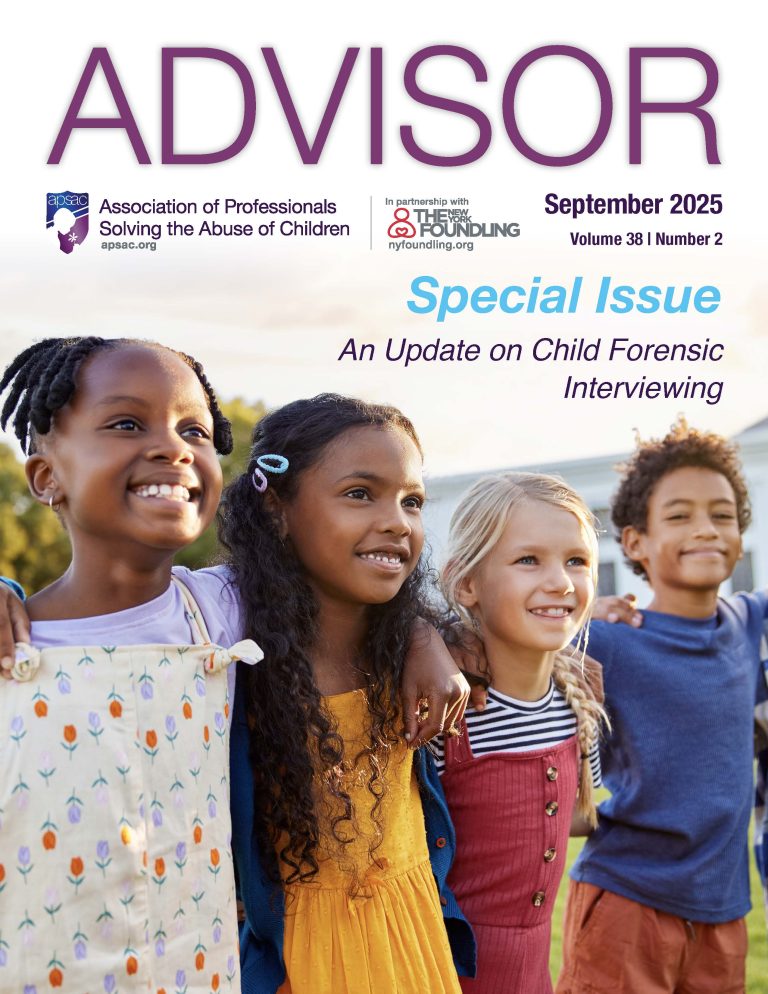APSAC Advisor
The APSAC Advisor is a peer reviewed quarterly news journal for professionals in the field of child abuse and neglect that highlights best practices in the field. The APSAC Advisor provides succinct, data-based, practice-oriented articles that keep interdisciplinary professionals informed of the latest developments in policy and practice in the field of child maltreatment.
Current Issue: Vol. 38(2)
Special Issue: An Update on Child Forensic Interviewing
Abstract
This article provides guidance for forensic interviewers and evaluators about the use of media (also called props, aids, and tools) in forensic assessments. It assumes that these professionals determine when in the assessment to use media. The article describes the rationale for the use of media, cites research that supports the use of media, and describes specific media and how to use them during the beginning phase, maltreatment phase, and closure phase of the assessment.
Key words: Forensic interviewing, forensic assessment, media, anatomical dolls, drawings, body diagrams
Abstract
Using anticipatory guidance, a method of providing a youth with information about what to expect, is an easily buildable skill that can enhance a youth’s experience of the forensic interview. This article describes methods of reducing a youth’s anxiety throughout the forensic interviewing process by using anticipatory guidance. Specific methods are described for anticipatory guidance during each phase: the pre-interview, interview instructions and expectations, narrative event practice, transition to the topic of concern, gathering details, taking a break/communicating with the MDT, clarification and closure, and presenting physical evidence (if applicable). The goal of anticipatory guidance is to minimize negative impact for youth while conducting legally sound interviews. Anticipatory guidance reframes the forensic interview as something we do WITH youth instead of TO youth.
Keywords: child forensic interview, anticipatory guidance, child sexual abuse, presenting evidence, prepare and predict
Abstract
This article discusses cultural competency principles and best practices when conducting forensic interviews with Spanish-speaking and bilingual children. Among the factors that interviewers need to consider are the many regional dialects of Spanish, the differences in social interaction between bilingual and monolingual children, the additional time required for Spanish-language interviews, the effects of a cultural practice of storytelling connected to family history, the ambiguity of some Spanish words, and code switching between English and Spanish in interviews. One important reality is that children find it very difficult to access and articulate feelings in a language in which they have less emotional connection.
Keywords: child abuse, forensic interviews, Spanish language forensic interviews, bilingual forensic interviews, cultural competency, cultural practice, code-switching, narrative practice, best practice
Abstract
This article reviews selected findings from research published from January 2022 to February 2025 that pertains to forensic interview questions and related methods. The article examines new research on a) practice narratives about children’s birthdays, b) different types of yes-no questions and an alternative to them, c) different types of prompts and transitions, d) different types of questions that use the word time, e) other types of questions, and f) wait times and breaks. The article then presents a brief list of recommendations from these researchers.
Keywords: child sexual abuse, child forensic interviewing, questioning methods
Abstract
This article reviews selected findings from research published from 2022 to February 2025 that pertains to other aspects of child forensic interviewing not directly related to questioning methods (a companion article examines research on questions and related methods). The review is divided into five broad categories: specific child populations, child psychological factors, professional factors, forensic interviewing supports, and general reviews of the field. The article then discusses implications for child forensic interviewing practice.
Keywords: child sexual abuse, child forensic interviewing






